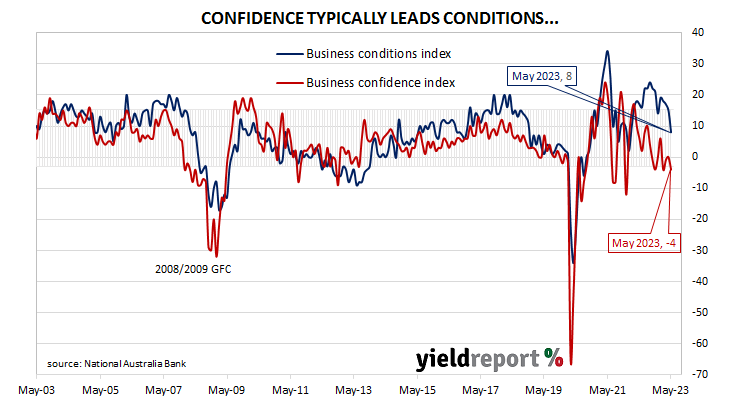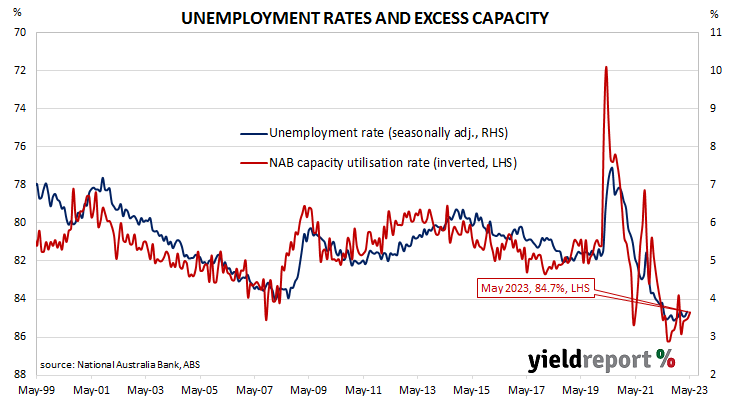Summary: Business conditions deteriorate in May; decline appears to be strengthening; business less confident, well below average; Westpac: likely confidence will move further into pessimistic territory; capacity utilisation rate slips, remains elevated.
NAB’s business survey indicated Australian business conditions were robust in the first half of 2018, with a cyclical-peak reached in April of that year. Readings from NAB’s index then began to slip and forecasts of a slowdown in the domestic economy began to emerge in the first half of 2019 as the index trended lower. It hit a nadir in April 2020 as pandemic restrictions were introduced but then conditions improved markedly over the next twelve months. Subsequent readings were generally in a historically-normal range until the second half of 2022.
According to NAB’s latest monthly business survey of around 500 firms conducted in last two weeks of May, business conditions have deteriorated for a fourth consecutive month to a level which is slightly above average. NAB’s conditions index registered 8 points, down 8 points from April’s revised reading.
NAB Chief Economist Alan Oster said the decline in business conditions “through early 2023 appears to be strengthening” but added “conditions remain above average reflecting just how strong the economy was through 2022.”
Business confidence also deteriorated. NAB’s confidence index fell from April’s revised reading of zero to -4 points, well below the long-term average. Typically, NAB’s confidence index leads the conditions index by one month, although some divergences have appeared from time to time.
The report was released on the same day as the latest Westpac-Melbourne Institute consumer sentiment survey and Commonwealth Government bond yields declined on the day. By the close of business, the 3-year ACGB yield had lost 2bps to 3.83%, the 10-year yield had slipped 1bp to 3.94% while the 20-year yield finished 3bps lower at 4.23%.
In the cash futures market, expectations regarding further rate rises in 2023 softened slightly while expectations regarding rises in the first half of 2024 firmed a little. At the end of the day, contracts implied the cash rate would rise from the current rate of 4.07% to average 4.145% in July and then to 4.285% in August. February 2024 contracts implied a 4.425% average cash rate while May 2024 contracts implied 4.28%, 21bps more than the current rate.
“This is the third occasion confidence has slipped to around these levels, with a reading of -3 last November and -4 in February,” observed Westpac senior economist Andrew Hanlan. “With the economic downturn to deepen, the likelihood is that business confidence will move further into pessimistic territory and that businesses will respond by paring back hiring plans and cut investment spending, particularly on equipment.”
NAB’s measure of national capacity utilisation eased back from April’s revised reading of 85.0% to 84.7%, remaining at a historically-elevated level. All eight sectors of the economy were reported to be operating above their respective long-run averages.
Capacity utilisation is generally accepted as an indicator of future investment expenditure and it also has a strong inverse relationship with Australia’s unemployment rate.



